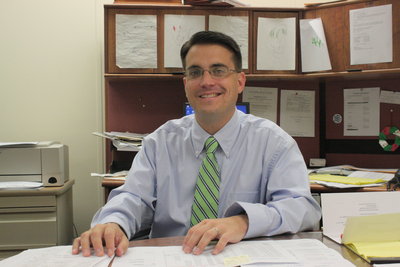Three weeks into his new job as Public Safety Director, Jason O’Donnell’s desk is already a pile of daily reports.
“This is what my job is about,” he said. “I review and I recommend.”
O’Donnell, who previously served as director of municipal services, combines two positions as part of Mayor Mark Smith’s effort to reduce the size of municipal government. His annual salary is $120,000 per year.
Previously, the fire and police departments each had their own director, although the fire director’s position had been vacant for several years. Smith, prior to being elected mayor in 1998, served as police director, then as mayor and director, until O’Donnell was named in late July.
Each morning, reports on department activities are piled on his desk for review, giving him an idea of what happened during the previous day.
“I read every police report, and I go out to every working fire.” – Jason O’Donnell
________
While not every incident report passes across his desk, all the important reports do, he said, along with current roster of personnel, reports on those who might be out sick, and other matters.
“I read every police report, and I go out to every working fire,” he said. “While I might not respond to a downed power line, I’ll know about it.”
Shrinking government without layoffs
O’Donnell, a fourth-generation Bayonne resident, said his goal for Bayonne is to cut costs without sacrificing safety. No layoffs are planned, he said, but cuts are being made through attrition.
Since 2008, the Fire Department has shrunk from 181 to 169 members and the Police Department has been reduced from 212 to 197, he said.
One of the key concerns the city is addressing are illegal apartments. A fire on West 11th Street two years ago resulted in the death of a man trapped in the attic.
Ironically, O’Donnell, a fire captain at the time, lived across the street from the building, which is currently being restored. He said he had raised concerns about the residence before the fire, but was out of the city on vacation when the fire occurred.
The city will likely start an occupancy registry that can be cross-referenced with city tax roles to address some of these issues, although the real answer is a combination of efforts by numerous departments.
“When I sat on the Planning Board, we were very cognizant of this, and asked a lot of questions about various projects, trying to make sure that spaces couldn’t be used for illegal residences.”
Duties cut across the board
Although as public safety director, he interacts mostly with police and fire departments, he is often in contact with other departments, including the Department of Public Works and the city’s zone managers.
“I get copied on zone manager reports,” he said, calling them additional eyes and ears in the community. “We can’t be everywhere, so we rely on these guys.”
As public safety director, O’Donnell’s duties are distinct from the police and fire chief.
“They are responsible for personnel and staffing,” O’Donnell said.
The chiefs decide assignments and other day-to-day specifics, while O’Donnell worries about how to find funding to pay for salaries and equipment. One of his responsibilities involves finding ways for the departments to work more efficiently.
“There is no question we need these police and firefighters,” he said. “But we need to find the money to pay for them.
Fortunately, for the city, the state appears poised to restore sales tax benefits to the city through the Urban Enterprise Zone, which funds some of the salaries for police officers and some firefighters.
O’Donnell said the new 2 percent cap on municipal spending poses a challenge when it comes to providing public safety, but since November 2008 when Mayor Smith took office the city has reduced its public safety salary costs by $2.49 million.
“That doesn’t include savings in health benefits,” he said. “But we did this without layoffs through attrition, and we’ve learned to do more with less. In our nine companies, we’re below 1998 numbers.”
“We did have to close one fire company,” he said. “But we’ve reallocated those duties to other departments.”
Firehouses need updating
One of the issues O’Donnell will have to face is the aging of the city’s fire houses. Most of them are 100 years old, designed for a time when fire trucks were driven by horses, and therefore not designed to handle the size or weight of modern equipment.
The city has installed steel columns and concrete supports for the 57th and 4th Street fire houses.
The construction of a new fire house on Route 440 near the entrance to the former Military Ocean Terminal will help, especially when operations at the Central Garage on Hook Road move to the new facility, providing more space for public works operations.
“We want to do more with shared services in both departments,” O’Donnell said.
The police department already has two officers involved in the Hudson County Prosecutor’s Joint Task Force, as well as the FBI’s Joint Task Force, and one with the DEA.
“These officers by being involved bring back money to the city through seizures,” O’Donnell said.
Al Sullivan may be reached at asullivan@hudsonreporter.com.
